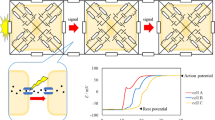Abstract
Fluorescent oxonol dyes were used to measure changes in the membrane potential of two different cell lines each expressing Pi-hydrolysis coupled muscarinic receptors. Both SK-N-SH human neuroblastoma cells and m1-transfected A9 L cells express muscarinic receptors, which, when stimulated, elicit a large increase in intracellular calcium, and release of inositol phosphates. Despite the similarity in this second-messenger response, muscarinic stimulation resulted in a hyperpolarization in the transfected A9 L cells whereas a small depolarization was observed in the neuroblastoma cells. The carbachol-mediated hyperpolarization of the transfected A9 L cells could be mimicked by increasing intracellular calcium with the ionophore A23187, suggesting, that it may be mediated by calcium-activated potassium channels. Exposure of SK-N-SH cells to A23187, on the other hand, had no effect on the membrane potential. These studies demonstrate that the activation of a second messenger system does not solely dictate the electrophysiological response of a cell, but that other factors such as the expression of ion-channels is critical in the determination of that response.
Similar content being viewed by others
References
Christie, M. L., and North, R. A. 1988. Control of ion conductances by muscarinic receptors. Trends in Pharmacol. Sciences Suppl. 3:30–34.
Jones S. V., Barker, J. L., Goodman, M. B., and Brann, M. R. 1990. Inositol trisphosphate mediates cloned muscarinic receptor-activated conductances in transfected mouse fibroblast A9L cells. J. Physiol. 421:499–519.
Blatz, A. L., Magleby, K. L. 1987. Calcium-activated potassium channels. Trends Neurosci. 11:463–467.
Fukuda, K., Higashida, H., Kubo, T., Maeda, A., Akiba, I., Bujo, H., Mishina, M., and Numa, S. 1988. Selective coupling with K+currents of muscarinic acetylcholine receptor subtypes in NG108-15 cells. Nature 335:355–358.
North, R. A. 1989. Muscarinic cholinergic receptor regulation of ion channels. Pages 341–373,in Brown, J.H. (ed.) The muscarinic receptors, Humana Press, Clifton, N.J.
Grove, E. A., Caulfield, M. P., and Evans, F. J. 1990. Inhibition of protein kinase C prevents phorbol ester-but not muscarine-induced depolarizations in the superior cervical ganglion. Neuroscience Letters 110:162–166.
Akerman, K. E. O. 1989. Depolarization of human neuroblastoma cells as a result of muscarinic receptor-induced rise, in cytosolic Ca2+. FEBS 242:337.
Baumgold, J. and Drobnick, A. 1989. An agonist that is selective for adenylate cyclase-coupled muscarinic receptors. Mol. Pharmacol. 36:465–470.
Jones, S. V., Barker, J. L., Buckley, N. J., Bonner, T. I., and Brann, M. R. 1988. Electrophysiological characterization of cloned m1 muscarinic receptors expressed in A9L cells. Proc. Natl. Acad. Science USA 85:4056–4060.
Jacobs, W. R., and Mandel, L. D. 1987. Fluorescent measurements of intracellular free calcium in isolated toad urinary bladder epithelial cells. J. Memb. Biol. 97:53–62.
Cruciani, R. A., Barker, J. L., Zasloff, M., Chen, H-C, and Calomonici, O. 1991. Antibiotic magainins exert cytolytic activity against transformed cell lines through channel formation. Proc. Natl. Acad. Sci. 88:3792–3796.
Fisher, S. K., and Snider, R. M. 1987. Differential receptor occupancy requirements for muscarinic cholinergic stimulation of inositol lipid hydrolysis in brain and in neuroblastomas. Mol. Pharm. 32:81–90.
Fisher, S., Domask, L. M., and Roland, R. M. 1989. Muscarinic receptor regulation of cytoplasmic Ca2+ concentrations in human SK-N-SH neuroblastoma cells: Ca2+ requirements for phospholipase C activation. Mol. Pharm. 35:195–204.
Wojcikiewicz, R. J. H., Safrany, S. T., Challiss, R. A., Strupish, J., and Nahorski, S. R. 1990. Coupling of muscarinic receptors to the mobilization of intracellular Ca2+ stores in permeabilized SH-SY5Y human neuroblastoma cells. Biochem. J. 272:269–272.
Appell, H.-J., and Bersch, B. 1987. Oxonol VI as an optical indicator of membrane potentials in lipid vesicles. Biochim. Biophys. Acta 903:480–494.
Baumgold, J., and Fishman, P. H. 1989. Muscarinic receptor-mediated increase in cAMP levels in SK-N-SH human neuroblastoma cells. Biochem. Biophys. Res. Comm. 154:1137–1143.
Owen, D. G., Segal, M., and Barker, J. L. 1984. A Ca2+-dependent Cl-conductance in cultured mouse spinal neurones. Nature 311:567–570.
Author information
Authors and Affiliations
Rights and permissions
About this article
Cite this article
Baumgold, J., Paek, R. Differences in the functional responses of two cell lines each expressing Pi-hydrolysis-coupled muscarinic receptors. Neurochem Res 17, 375–379 (1992). https://doi.org/10.1007/BF00974580
Accepted:
Issue Date:
DOI: https://doi.org/10.1007/BF00974580




